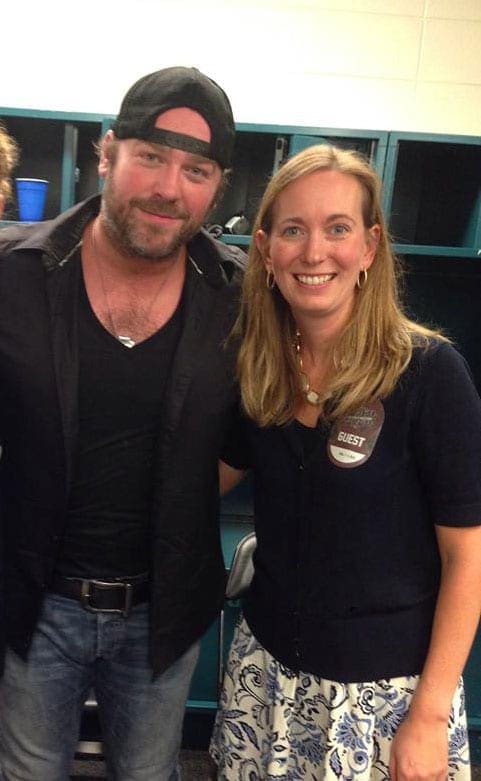Musician’s Hearing Services
for musicians, hearing well is essential for their art.

Dr. Wayne with Steve Miller.
Hearing Protection for Musician's
Below please find several of the filters we carry that have been designed specifically for the needs of musician’s.
Custom Musician's Earplug ER-9
The ER-9 provides 9 dB of attenuation to about 2000 Hz, and 15 dB attenuation in the higher frequencies. Musician’s find this attenuator appropriate when less than 15 dB attenuation is desired.
Custom Musician's Earplug ER-15
The ER-15 Musicians Earplug is appropriate for most musical applications
Custom Musician's Earplug ER-25
The ER-25 was developed at the request of percussionists and those who perform in loud concert halls. These individuals, require additional attenuation to be adequately protected from high sound levels
High Fidelity Earplug ER-20
Although not a custom fit earplug, this earplug was designed with concert goers in mind. They reduce most noise to safe levels while preserving the clarity of speech and the richness of music.

Dr. Wayne with Steve Miller.
Why Choose Musician’s Earmolds?
Musician’s earplugs are designed to replicate the natural response of sound. As a result, the sounds that you hear are the same quality as the original – only quieter. The result is the ability to hear speech and music clearly, as the ear reads the full blended frequencies. You can feel the bass and distinguish each tone. But because direct pressure to the ears is reduced, the level of damage is reduced.
We offer several types of filters for the musician plugs (ER 9, 15, and 25). The higher the number the more attenuation of the music. Dr. Wayne can review these filters with you. We also take impressions for in-ear monitors for various companies including Future Sonics.
The Need for Musician’s Earmolds
Dr. Wayne has worked with numerous bands including such well-known bands as The Steve Miller Band, Fleetwood Mac
The effects of repeated exposure to loud music will impact your hearing. Listening to loud music can cause the cilia (hair cells in the inner ear) to become tired and worn. Over time, the cilia will eventually fail to recover, resulting in a permanent loss of hearing.
Loud music, especially during concerts, can be detrimental to your hearing. A minor hearing loss will affect the perceptions of tone and pitch that are required for ideal performance. In extreme cases, severe hearing loss could mean the end of a career.
the decibel level of musical instruments
Did you ever wonder how loud musical instruments and concerts really are? From Eastern Kentucky School of Music
Cello 85dB to 111dB
Tinnitus (pronounced “tin-it-tus”) is an abnormal noise in the ear. Tinnitus is extremely common – nearly 36 million Americans have tinnitus. More than half of the normal population has intermittent tinnitus.
About 6% of the general population has what they consider to be “severe” tinnitus. It can sound like a low roar, a high-pitched ring or a variety of other sounds. Tinnitus may be in both ears or just in one ear. Seven million Americans are so severely affected that they cannot lead normal lives.
Flute 92dB to 103dB
Types of tinnitus
There are two different categories or types of tinnitus.
Subjective tinnitus is tinnitus only you can hear. This is the most common type of tinnitus. It can be caused by ear problems in your outer, middle or inner ear. It also can be caused by problems with the hearing (auditory) nerves or the part of your brain that interprets nerve signals as sound.
Objective tinnitus (believe it or not) is tinnitus your doctor can hear when he or she does an examination. This rare type of tinnitus may be caused by a blood vessel problem, an inner ear bone condition or muscle contractions.
Clarinet 85dB to 114dB
There are many causes of tinnitus, here are just a few
- Ear wax.
- Exposure to loud noise
- middle ear infection or fluid
- injury to the nerve from the ear to the brain, and central nervous system damage.
- aneurysms,
- increased pressure in the head (hydrocephalus), and
- hardening of the arteries.
- Brain tumors
- Loud noise both short term and long term. inner ear damage and tinnitus.
- Medications
Symphony 120dB to 137dB
Of adults ages 65 and older in the United States, 12.3 percent of men and nearly 14 percent of women are affected by tinnitus. Tinnitus is identified more frequently in white individuals and the prevalence of tinnitus is almost twice as frequent in the South as in the Northeast.
Rock Concert Peak 150dB
Tinnitus can be perceived in both ears, one ear or in some patients in the middle of the head and not in the ear.
Musician's and Hearing Loss
A 2014 study in Occupational & Environmental Medicine reports that musicians face nearly four times greater risk of developing hearing loss than the rest of the public, and are 57 percent more likely to develop tinnitus (ringing in the ears) due to exposure to loud music.
The researchers reviewed the medical records of three million Germans aged 19 to 66, including 2,227 professional musicians. Among nearly 284,000 cases of hearing loss overall, 238 professional musicians experienced some degree of hearing loss, even after controlling for hearing loss that could be caused by aging, not noise exposure.

Dr. Wayne with Lee Brice.
How Loud is Too Loud?
As a general rule, noise may damage your hearing if:
You have to shout over background noise to make yourself heard.
The noise makes your ears ring.
You have decreased or “muffled” hearing several hours after exposure.
The noise is painful to your ears.
Don't Wait Any Longer. Start Your Path to Better Hearing Today!
Newtown/Langhorne Office
207 Corporate Drive East
Luxemborg Corporate Center
Langhorne, PA 19047
Langhorne Phone
Hours
Please call for an appointment.
Fax
Message Us
Doylestown Office
101 Progress Drive,
Doylestown, PA 18901
Doylestown Phone
Hours
Please call for an appointment.
